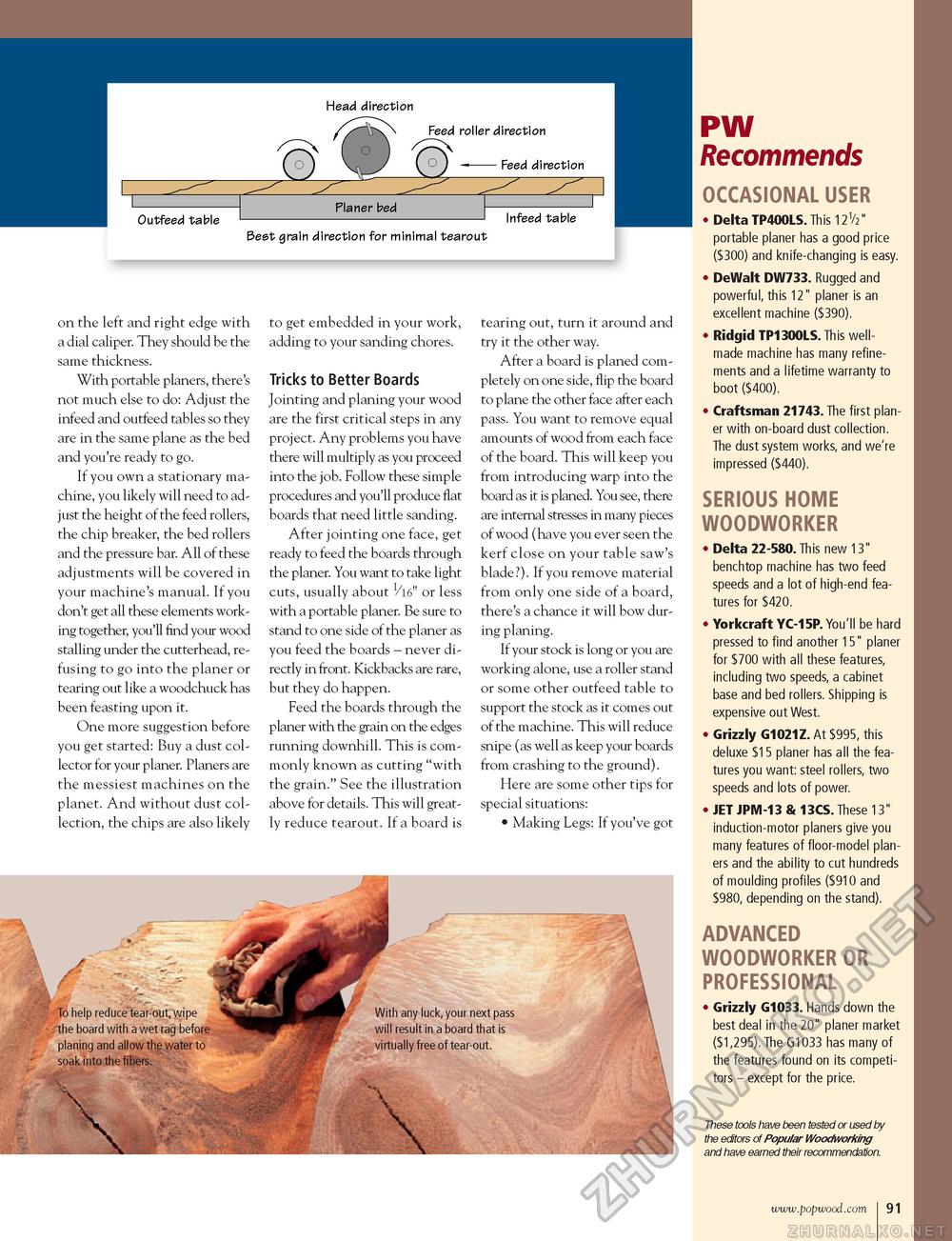Popular Woodworking 2002-10 № 130, страница 89
Head direction Feed roller direction Feed direction Outfeed table Infeed table Best grain direction for minimal tearout on the left and right edge with a dial caliper. They should be the same thickness. With portable planers, there's not much else to do: Adjust the infeed and outfeed tables so they are in the same plane as the bed and you're ready to go. If you own a stationary machine, you likely will need to adjust the height of the feed rollers, the chip breaker, the bed rollers and the pressure bar. All of these adjustments will be covered in your machine's manual. If you don't get all these elements working together, you'll find your wood stalling under the cutterhead, refusing to go into the planer or tearing out like a woodchuck has been feasting upon it. One more suggestion before you get started: Buy a dust collector for your planer. Planers are the messiest machines on the planet. And without dust collection, the chips are also likely to get embedded in your work, adding to your sanding chores. Tricks to Better Boards Jointing and planing your wood are the first critical steps in any project. Any problems you have there will multiply as you proceed into the job. Follow these simple procedures and you'll produce flat boards that need little sanding. After jointing one face, get ready to feed the boards through the planer. You want to take light cuts, usually about 1/l6" or less with a portable planer. Be sure to stand to one side of the planer as you feed the boards - never directly in front. Kickbacks are rare, but they do happen. Feed the boards through the planer with the grain on the edges running downhill. This is commonly known as cutting "with the grain." See the illustration above for details. This will greatly reduce tearout. If a board is To help reduce'tear-out, wipe the board with a wet rag before planing and allow the water to soak into the fibers. \ tearing out, turn it around and try it the other way. After a board is planed completely on one side, flip the board to plane the other face after each pass. You want to remove equal amounts of wood from each face of the board. This will keep you from introducing warp into the board as it is planed. You see, there are internal stresses in many pieces of wood (have you ever seen the kerf close on your table saw's blade?). If you remove material from only one side of a board, there's a chance it will bow during planing. If your stock is long or you are working alone, use a roller stand or some other outfeed table to support the stock as it comes out of the machine. This will reduce snipe (as well as keep your boards from crashing to the ground). Here are some other tips for special situations: • Making Legs: If you've got With any luck, your next pass will result in a board that is virtually free of tear-out. OCCASIONAL USER Delta TP400LS. This 12/2" portable planer has a good price ($300) and knife-changing is easy. • DeWalt DW733. Rugged and powerful, this 12" planer is an excellent machine ($390). • Ridgid TP1300LS. This well-made machine has many refinements and a lifetime warranty to boot ($400). • Craftsman 21743. The first planer with on-board dust collection. The dust system works, and we're impressed ($440). SERIOUS HOME WOODWORKER • Delta 22-580. This new 13" benchtop machine has two feed speeds and a lot of high-end features for $420. • Yorkcraft YC-15P. You'll be hard pressed to find another 15" planer for $700 with all these features, including two speeds, a cabinet base and bed rollers. Shipping is expensive out West. • Grizzly G1021Z. At $995, this deluxe $15 planer has all the features you want: steel rollers, two speeds and lots of power. • JET JPM-13 & 13CS. These 13" induction-motor planers give you many features of floor-model planers and the ability to cut hundreds of moulding profiles ($910 and $980, depending on the stand). ADVANCED WOODWORKER OR PROFESSIONAL • Grizzly G1033. Hands down the best deal in the 20" planer market ($1,295). The G1033 has many of the features found on its competitors - except for the price. These tools have been tested or used by the editors of Popular Woodworking and have earned their recommendation. 91 |








